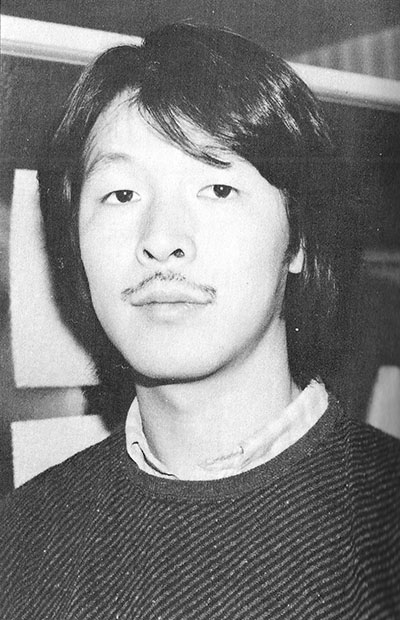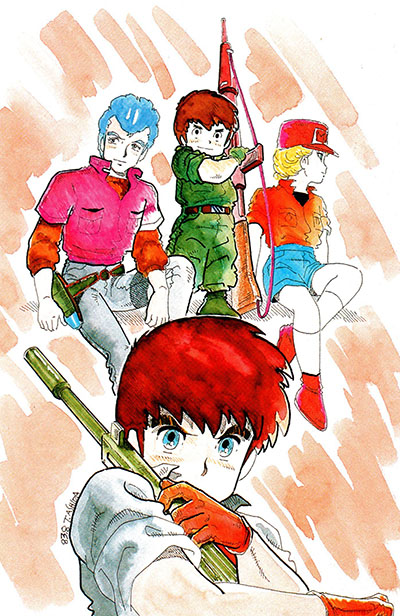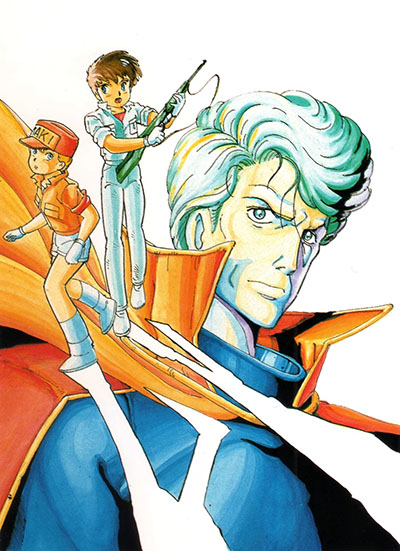Interview with Producer Masuo Ueda

Photo taken in 1985
Masuro Ueda was involved in this project at Nippon Sunrise [now Sunrise], and Vifam was his debut as a producer. We asked him about the hardships he faced in creating this work.
Not a producer but a “paroducer”?
Interviewer: This was your first time to work with the Dainichi Broadcasting System, wasn’t it?
Ueda: It was my first time for Sunrise. However, when I was working for Soueisha, the predecessor of Sunrise, we did a series called KumKum (1975), which was produced by Mainichi Broadcasting System and Tohoku Shinsha. Yoshihiko Marutani, who was in charge of Vifam, was also the producer of KumKum.
Interviewer: You worked on the theatrical version of Mobile Suit Gundam, but Vifam was your first TV series.
Ueda: This was the first time I started a project from zero. It was practically my debut work. In that sense, it was unforgettable. I had a lot of worries, and I also had goals that I wanted to achieve. I learned a lot from it.
Interviewer: [Character Designer] Toyoo Ashida told me that you were the youngest producer in Japan at that time.
Ueda: Yes, I was. But soon there were more young people coming up. At that time, anime as a whole was in full swing, and there were many works. Mr. Ashida and I both liked parody, and we played with it a lot. I was called a “paroducer” in magazines (laughs), and we did whatever we wanted.
Interviewer: What pains did you go through as a producer?
Ueda: Nothing in particular. I was fortunate that there was a lot of time between the decision to make this series and its broadcast premiere. I had enough time to think about everything at the beginning, and I was able to build the schedule carefully.
Interviewer: The original draft has Yoshiyuki Tomino’s name on it. [Translator’s note: Tomino created Sunrise’s biggest franchise of all time, Mobile Suit Gundam.]
Ueda: He participated in the project when the working title was still Greidos. However, he was working on another TV series at the time, so it was impossible for him to stay on it.
Interviewer: I heard that it originally started as a plamodel [plastic model kit] project.
Ueda: At the time, Gundam‘s plamodels were very popular, and Bandai’s hobby department wanted to create another brand. So we decided to start a new project. However, even though it was in line with Gundam, there was no point in doing the same thing. Basically, I wanted to make a robot drama with a realistic setting.
I wondered what would happen if we changed the story by centering it on children. That’s when we started to work on the specifics. After discussing it with [Director] Takeyuki Kanda, Toyoo Ashida, [Writer] Hiroyuki Hoshiyama and other writers, we came up with the main concept.
We decided on a space version of Two Years’ Vacation, with robots and science fiction. For a different touch, I wanted to depict children trying their best to survive. When they come back to Earth, they look cool because they have done it all by themselves. That concept was solidified. How to arrange it and how to make it interesting were the challenges.
Interviewer: Who selected the main staff?
Ueda: Eiji Yamaura, who was the managing director of Sunrise at the time, decided on Mr. Kanda (director) and Mr. Hoshiyama (co-creator). I joined the team when they asked me who to choose as a character designer. There were many candidates, but I thought Toyoo Ashida would be a good choice. I guess I was betting on having unexpected characters. I thought it would be good for them not to be typical robot-anime characters.
Gundam broke through the preconceived notions of what a robot should be, so we wanted to try something new. It was the first time for us, so we didn’t know what to be afraid of, and we were ready to do anything. I like to do things that others haven’t done before.
Interviewer: Mr. Ashida had done other original works for Sunrise.
Ueda: The one before Vifam was Minky Momo. To be honest, at first I wondered, “Can this even be done?” I wondered if some young staff member from Studio Live would be able to do it.
Interviewer: Why did you decide on Mr. Ashida?
Ueda: I think we were on the same wavelength. When I told him that I wanted to do something different, he readily agreed. Also, for me, the fact that Mr. Ashida had an excellent art studio called Studio Live was a big factor.
Sunrise’s base was their first and second studios, and most of the animators worked at one or the other [on existing shows]. So if we started a new studio, we wouldn’t have any staff. In such a situation, having a veteran like Mr. Ashida join the project was very helpful for us, since we had to start the project with no strength of our own.
Interviewer: This was the first Sunrise project for many of the other staff members, wasn’t it?
Ueda: I went through my animation contacts and talked to many people, but a lot of them were turned off when they heard that there were thirteen characters. (Laughs) I was asked, “Will they all be moving around on the screen?” I said, “No, no, it’s fine” (laughs). I didn’t know what was acceptable, but the staff did a great job moving the characters around, and I’m grateful for that.
Interviewer: What is the origin of the slightly soft-sounding title Vifam?
Ueda: At first, the title was Greidos, but that sounded a little stiff. The name “Pham” is a remnant of my initial attempt to give it an airplane-like image, like Phantom. Pham, in essence, is a name for a specific aircraft, like the Vifam or the Neofam.
When it came time to decide what to put in front of it, Mr. Kanda said “Ba” would be good. That’s how we came up with Baifam. We also decided to use V for the first letter. That’s why you see Vaifam on the front page of the storyboard for the first episode. We couldn’t just use the letter V due to trademark registration and other reasons, so it became Vifam.
Mr. Yamaura thought it would be a jinx and said “we have to get the N from Phan in there,” but in the end there was no ‘n’.
A “Sharon menstruation” episode was written
Interviewer: What went on at the Chichibu training camp with the main staff?
Ueda: The purpose was to decide the characterization of the story and characters. When it comes to personalities, I was not convinced that the children in famous anime were portrayed as genuine images of children. I felt that children are not that innocent, that they should be more raw. They lie and deceive others. When we look back we think of it as cute, because it’s what children do. That’s what we were like when we were kids, isn’t it? If we remembered what it was really like, we could create more realistic characters that we could fall in love with.
So I took the characters Mr. Ashida drew and gave each one a personality. I thought, “If this one clashes with that one, we could get a story out of it.” I decided that one would be a leader, but not like a leader. The whole story is unrealistic, so I thought I wouldn’t hold up unless the characters were real. That’s how I thought we should make it, and I think it turned out to be a good idea.
Before we went to the camp, there were about ten characters, and we each expressed our own preferences. “I’d like to have this kind of character, too.” That’s how we ended up with thirteen. (laughs) Kentsu was Mr. Kanda’s favorite. Kanda is a very gentle person, but he also loves military-types.
Interviewer: Kachua was originally a boy named Tops. Why did you change it?
Ueda: Is that right? I don’t remember that at all. It’s true that Kachua was the last character to be created. I guess it was because I couldn’t decide until the end whether or not to include an alien in the story. The reason she became a girl was probably for the simple reason that, well, girls are better than boys. I guess it was a simple reason. I think I also considered the fact that she would get along well with Rodey.
Interviewer: [Writer] Yasushi Hirano said, “On the way back from the Chichibu camp, Mr. Ueda asked me to do an episode about wet dreams.”
Ueda: I didn’t say that. (Laughs) Well, I may have said that. But usually it’s the other way around. The writer wants to do something like that, but the producer stops him. That’s how it goes. He was reluctant to write something like that when it came up, but I said, “Why not?”
However, Tsunehisa Ito wrote a script that had Sharon menstruating. Like in Yoshiharu Tsuge’s Red Flowers manga, red flower petals float down from the upper reaches of the river. Kentsu picks one up, and when he starts to go upstream, he finds Sharon shouting, “Don’t come over here!”
The script was already written, but after discussing it with [Producer] Yoshihiko Marutani, we decided that it was too much for golden hour [prime time for children], so it was dropped.
Interviewer: You tried to cast voice actors who were close to their character’s age.
Ueda: At first, I was thinking of doing that for all the actors, but it would have been difficult to cast all of them that way, so we decided to ask veterans to join us as well.
Interviewer: Also, the all-English theme song was quite novel at the time.
Ueda: The record was released by Warner Pioneer at the time. Mr. Seki, the director of Warner Pioneer, and Mr. Marutani and I discussed what to do for the theme song. There were a lot of conditions, such as the title of the series had to be included, but Japanese lyrics with the title Vifam didn’t seem to fit. We came to the conclusion that because it was a program that elementary school students would watch, it didn’t mean the lyrics had to be in Japanese.
We used to listen to the Beatles when we were in 4th and 5th grade and thought that even if you don’t understand the lyrics, you can still understand the song if it’s good. So we decided to put everything in English. It was the same as coming up with the characters, going back to what we were like as kids. Even if we didn’t understand the lyrics, we enjoyed listening to the Beatles, Stones, Zeppelin, etc. in elementary school and junior high. It’s about cherishing that feeling. If it was incompatible with the overall tone of the work, that’s one thing. But if not, I was willing to do it.
I was worried about what the sponsor would say, but it worked out. There was an opinion that it would be better to put the lyrics on the screen, but we didn’t, because we felt that there was no use showing something we couldn’t read. Thanks to that, the theme song turned out to be a hit. This led to requests from various companies to use our band. That’s how TM Network got started, which led to City Hunter (1987).
Anyway, I think it’s important to break the rules of children’s shows and robot shows. The first thing I had in mind was to defy the expectations of the fans. It wasn’t just a matter of breaking the rules; if it linked well with what I wanted to do, then there was no need to get caught up in conventional methodology. That’s what I’ve been doing.
Interviewer: At that time, you said you didn’t want to make it just for maniacs [otaku]. Such anime began to appear at that time. Did you feel like it was a trend?
Ueda: The world of anime was expanding with Gundam, but I felt that fans were heading in the direction of a niche. I like niche things, but I don’t like niche-oriented work, so I try to be mainsteam-oriented. After all, Vifam was on at 7pm on Friday nights, and we had to fight against Doreamon [a very long-running family-oriented comedy anime]. It had to be a robot show that the whole family could watch. I was making the show to get as many viewers as possible.
So even if the robot didn’t play an active role in every episode, if the story was interesting, people would watch it. I thought that if it became popular, it would sell more products. I think that’s how it turned out. In fact, we received many fan letters from ordinary girls who didn’t usually watch anime, but only watched this one. That was very encouraging.
When there were rumors that the show was going to be canceled, I received letters saying, “Please continue.” There were times when I wrote thank-you letters from the studio. I even enclosed a postcard with Mr. Ashida’s autograph on it.
Struggles in the latter half and avoiding cancellation
Interviewer: When did you start to hear about cancellation?
Ueda: Around December [1983]. There was talk that we might not be able to continue in this time slot anymore. The ratings were in single digits for that time slot, which was a big factor. Until the decision was made, we were simultaneously working on scripts that would end it in two arcs [26 episodes] and alternate scripts that would continue on.
Fortunately, model kit sales were going very well, and Bandai wanted to continue the project as a sponsor. The people in charge at the network did their best, and we managed to move the time slot and keep going. There were some conditions, such as powering up the mecha and adding more battle scenes. It was better for the show to continue. If it had ended with two arcs, I don’t think it would have become as popular as it did.
Interviewer: Were there any specific directives from the network?
Ueda: I enjoyed working with them, so there were no orders. If something was said by sponsor, we were ready to cooperate and come up with a solution together.
Interviewer: You heard various things from the network and the sponsor, but you were able to keep your head above water.
Ueda: Yes, I did get a lot of comments. “Why does it take so long for the main character to get on the robot?” [Episode 12] So we put a lot of fight scenes in the first three episodes so that the robot gets more screen time. Then, after the kids were left alone, their survival would become the main focus. Even if Rodey and the others got on the Vifam, there would be almost no battle scenes, and I thought they’d be fine with that. Some might have wondered if it would be okay, but I was confident.
Interviewer: The tone of the work changed a lot in the second half.
Ueda: It became difficult for the story to proceed with just the children, and we had to bring in Meuller [the enemy rival], but I regret that it was a little awkward.
Interviewer: The story always progresses from the point of view of the children, doesn’t it?
Ueda: The original concept was to not put any cameras on the enemy side. That’s why it’s scary. The idea was to survive while fighting an unknown enemy with no idea what they’re thinking. But when you create a story from a child’s point of view, there are always limits. So I think it was necessary to expand the story. It was a lot of work, but we didn’t have to worry about the ratings as much as we did at 7pm, so it was easier.
Interviewer: You made a new work called Vifam 13 (1998) a few years ago, how did that come about?
Ueda: I received a proposal from Mainichi Broadcasting System to do some kind of late night anime. At that time, Mr. Kanda passed away. I thought, “Oh, this means I won’t be able to do Vifam anymore.” But I also felt that if I could do it again, I would. It was right around the time when Evangelion was booming. I thought it would be necessary to do something with a “healing” robot. (Laughs) [As opposed to Eva, which was all about trauma.]
But it was difficult to recreate something that had already been done once. We had various ideas, such as making it a sequel or putting different characters in the same setting. But we decided that it wouldn’t be Vifam without the originals. So that’s how we came up with the story. We could have portrayed them as they grew up 13 years later, but I didn’t want to do it that way. At that time, we all had children of our own, and I was wondering if we could drift through space with 40 people in total. (Laughs) It would be like The Drifting Classroom, but I thought that would get out of hand.
(January 23, 2002, at Sunrise headquarters)
See Masuo Ueda’s profile on Anime News Network here


